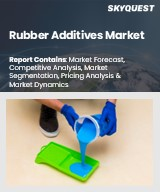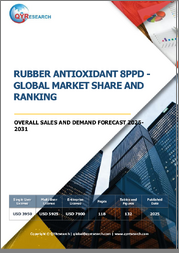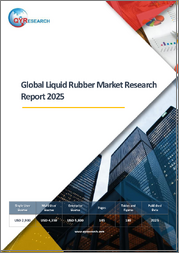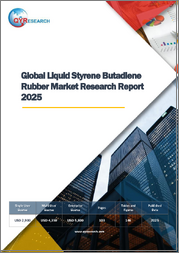
|
시장보고서
상품코드
1621294
방위용 고무 재료 시장 : 재료, 제품, 판매 채널, 플랫폼별 - 세계 예측(2025-2030년)Rubber Materials for Defence Market by Material (Acrylic Rubber, Butadiene Rubber, Butyl Rubber), Product (Anti-Vibration Mountings, Belt, Bullets), Sales Channel, Platform - Global Forecast 2025-2030 |
||||||
방위용 고무 재료 시장의 2023년 시장 규모는 85억 4,000만 달러로 평가되었습니다. 2024년에는 90억 8,000만 달러에 이를 것으로 예측되며 CAGR 6.43%로 성장하여 2030년에는 132억 3,000만 달러에 달할 것으로 예상됩니다.
국방 분야의 고무 소재 시장은 씰, 개스킷, 호스, 군용 차량, 항공기 및 해군 시스템에 필수적인 방진 부품 등 다양한 용도로 사용되고 있습니다. 이 소재의 필요성은 높은 내구성, 유연성, 극한의 온도 및 화학 물질에 대한 내성 등 고유한 특성으로 인해 발생하며, 가혹한 조건에서 신뢰성과 성능이 요구되는 방위 활동에 필수적인 요소로 작용합니다. 최종 용도는 주로 군사 및 방위 분야로, 보호복, 차량용 신발, 탄도 보호 등에 적용됩니다. 시장 성장의 원동력은 국방비 증가, 군비 현대화, 성능과 안전성을 향상시키는 첨단 소재에 대한 니즈입니다. 또한, 내열성 및 수명 향상과 같은 특성이 강화된 새로운 고무 화합물의 개발은 유리한 기회를 제공합니다. 중요한 권장사항은 지속가능성과 재료 특성을 향상시키는 나노기술의 통합에 초점을 맞춘 연구에 투자하는 것입니다. 그러나 원자재 가격 변동, 제조 비용 상승, 공급업체들의 규정 준수를 복잡하게 만드는 까다로운 규제 기준 등이 시장 성장의 걸림돌로 작용하고 있습니다. 이러한 제약에 대응하기 위해서는 전략적 파트너십과 기술 혁신에 대한 투자가 필요합니다. 환경 영향을 줄이기 위한 생분해성 및 재활용이 가능한 고무 소재와 우수한 강도 대 중량비를 제공하는 하이브리드 복합소재는 혁신에 적합한 분야입니다. 이러한 기술 혁신을 도입할 수 있는 기업은 보다 지속 가능하고 고성능의 재료를 요구하는 방위 기관의 진화하는 요구에 부응함으로써 경쟁 우위를 확보할 수 있습니다. 이 시장의 특성은 재료 과학의 발전과 군용 용도의 진화하는 요구사항에 크게 영향을 받기 때문에 이러한 변화를 예측하고 적응할 수 있는 기업이 큰 시장 점유율을 차지할 가능성이 높습니다.
| 주요 시장 통계 | |
|---|---|
| 기준년(2023) | 85억 4,000만 달러 |
| 추정년(2024) | 90억 8,000만 달러 |
| 예측년(2030) | 132억 3,000만 달러 |
| CAGR(%) | 6.43% |
시장 역학: 빠르게 진화하는 방산용 고무 소재 시장의 주요 시장 인사이트 공개
국방용 고무 소재 시장은 수요 및 공급의 역동적인 상호작용에 의해 변화하고 있습니다. 이러한 시장 역학의 변화를 이해함으로써 기업은 정보에 입각한 투자 결정을 내리고, 전략적인 의사결정을 정교화하며, 새로운 비즈니스 기회를 포착할 수 있습니다. 이러한 트렌드를 종합적으로 파악함으로써 기업은 정치적, 지리적, 기술적, 사회적, 경제적 영역 전반에 걸친 다양한 리스크를 줄일 수 있으며, 소비자 행동과 그것이 제조 비용 및 구매 동향에 미치는 영향을 보다 명확하게 이해할 수 있습니다.
- 시장 성장 촉진요인
- 경량화 및 첨단 방산제품의 세계 트렌드 증가
- 방위 장비의 밀봉 및 배리어 층에 고무 제품 사용 증가
- 시장 성장 억제요인
- 고무 재료와 관련된 원자재 비용의 급등
- 시장 기회
- 방위산업에 대한 정부 지원 및 지출
- 고무 재료의 재료 및 제조 발전
- 시장 과제
- 고무 재료에 대한 제조 복잡성 및 호환성 문제
Porter's Five Forces: 방산용 고무 소재 시장 탐색을 위한 전략 도구
Porter's Five Forces 프레임워크는 시장 상황경쟁 구도를 이해하는 중요한 도구입니다. Porter의 Five Forces 프레임워크는 기업의 경쟁력을 평가하고 전략적 기회를 탐색할 수 있는 명확한 방법을 제공합니다. 이 프레임워크는 기업이 시장 내 세력도를 평가하고 신규 사업의 수익성을 판단하는 데 도움이 됩니다. 이러한 통찰력을 통해 기업은 강점을 활용하고, 약점을 해결하고, 잠재적인 도전을 피하고, 보다 강력한 시장 포지셔닝을 확보할 수 있습니다.
PESTLE 분석 : 방산용 고무 소재 시장의 외부 영향 파악
외부 거시 환경 요인은 방산 고무 소재 시장의 성과 역학을 형성하는 데 매우 중요한 역할을 합니다. 정치적, 경제적, 사회적, 기술적, 법적, 환경적 요인에 대한 분석은 이러한 영향을 탐색하는 데 필요한 정보를 제공하며, PESTLE 요인을 조사함으로써 기업은 잠재적 위험과 기회를 더 잘 이해할 수 있습니다. 이러한 분석을 통해 기업은 규제, 소비자 선호도, 경제 동향의 변화를 예측하고 선제적이고 능동적인 의사결정을 내릴 준비를 할 수 있습니다.
시장 점유율 분석 방산용 고무 소재 시장에서경쟁 구도 파악
국방용 고무 재료 시장의 상세한 시장 점유율 분석을 통해 공급업체의 성과를 종합적으로 평가할 수 있습니다. 기업은 수익, 고객 기반, 성장률과 같은 주요 지표를 비교하여 경쟁적 위치를 파악할 수 있습니다. 이 분석은 시장의 집중화, 단편화 및 통합 추세를 파악할 수 있으며, 공급업체는 치열한 경쟁 속에서 자신의 입지를 강화할 수 있는 전략적 의사결정을 내리는 데 필요한 통찰력을 얻을 수 있습니다.
FPNV 포지셔닝 매트릭스 방어용 고무 소재 시장에서의 벤더의 성능 평가
FPNV 포지셔닝 매트릭스는 방산 고무 소재 시장에서 공급업체를 평가하는 중요한 도구입니다. 이 매트릭스를 통해 비즈니스 조직은 벤더의 비즈니스 전략과 제품 만족도를 기반으로 평가하여 목표에 부합하는 정보에 입각한 의사결정을 내릴 수 있으며, 4개의 사분면으로 벤더를 명확하고 정확하게 세분화하여 전략 목표에 가장 적합한 파트너와 솔루션을 식별할 수 있습니다. 전략 목표에 가장 적합한 파트너와 솔루션을 식별할 수 있습니다.
방위산업용 고무 소재 시장에서 성공하기 위한 전략 분석 및 권장 사항
국방용 고무 소재 시장의 전략적 분석은 세계 시장에서의 입지를 강화하고자 하는 기업에게 필수적입니다. 주요 자원, 역량 및 성과 지표를 검토함으로써 기업은 성장 기회를 식별하고 개선할 수 있습니다. 이러한 접근 방식을 통해 경쟁 환경의 도전을 극복하고 새로운 비즈니스 기회를 활용하여 장기적인 성공을 거둘 수 있도록 준비할 수 있습니다.
이 보고서는 주요 관심 분야를 포괄하는 시장에 대한 종합적인 분석을 제공합니다.
1. 시장 침투도 : 현재 시장 환경의 상세한 검토, 주요 기업의 광범위한 데이터, 시장 도달 범위 및 전반적인 영향력 평가.
2. 시장 개척도: 신흥 시장에서의 성장 기회를 파악하고, 기존 분야의 확장 가능성을 평가하며, 미래 성장을 위한 전략적 로드맵을 제공합니다.
3. 시장 다각화 : 최근 제품 출시, 미개척 지역, 업계의 주요 발전, 시장을 형성하는 전략적 투자를 분석합니다.
4. 경쟁 평가 및 정보 : 경쟁 구도를 철저히 분석하여 시장 점유율, 사업 전략, 제품 포트폴리오, 인증, 규제 당국의 승인, 특허 동향, 주요 기업의 기술 발전 등을 검토합니다.
5. 제품 개발 및 혁신 : 미래 시장 성장을 가속할 것으로 예상되는 첨단 기술, 연구 개발 활동 및 제품 혁신을 강조합니다.
이해관계자들이 충분한 정보를 바탕으로 의사결정을 내릴 수 있도록 다음과 같은 중요한 질문에 대한 답변도 제공합니다.
1. 현재 시장 규모와 향후 성장 전망은?
2. 최고의 투자 기회를 제공하는 제품, 부문, 지역은?
3. 시장을 형성하는 주요 기술 동향과 규제의 영향은?
4. 주요 벤더 시장 점유율과 경쟁 포지션은?
5.벤더 시장 진입 및 철수 전략의 원동력이 되는 수익원과 전략적 기회는 무엇인가?
목차
제1장 서문
제2장 조사 방법
제3장 주요 요약
제4장 시장 개요
제5장 시장 인사이트
- 시장 역학
- 성장 촉진요인
- 성장 억제요인
- 기회
- 과제
- 시장 세분화 분석
- Porter's Five Forces 분석
- PESTEL 분석
- 정치적
- 경제적
- 사회적
- 기술적
- 법적
- 환경적
제6장 방위용 고무 재료 시장 : 소재별
- 아크릴 고무
- 부타디엔 고무
- 부틸 고무
- 클로로설폰화 폴리에틸렌
- 불소 엘라스토머
- 이소프렌 고무
- 니트릴 고무
- 퍼플루오로엘라스토머
- 폴리클로로프렌
- 폴리설파이드 고무
- 실리콘 고무
- 스티렌 부타디엔 고무
제7장 방위용 고무 재료 시장 : 제품별
- 방진 마운트
- 벨트
- 총알
- 신발
- 호스
- 롤러
- 추적
제8장 방위용 고무 재료 시장 : 판매 채널별
- 애프터마켓
- 제조업체
제9장 방위용 고무 재료 시장 : 플랫폼별
- 공중
- 지면
- 마린
제10장 아메리카의 방위용 고무 재료 시장
- 아르헨티나
- 브라질
- 캐나다
- 멕시코
- 미국
제11장 아시아태평양의 방위용 고무 재료 시장
- 호주
- 중국
- 인도
- 인도네시아
- 일본
- 말레이시아
- 필리핀
- 싱가포르
- 한국
- 대만
- 태국
- 베트남
제12장 유럽·중동 및 아프리카의 방위용 고무 재료 시장
- 덴마크
- 이집트
- 핀란드
- 프랑스
- 독일
- 이스라엘
- 이탈리아
- 네덜란드
- 나이지리아
- 노르웨이
- 폴란드
- 카타르
- 러시아
- 사우디아라비아
- 남아프리카
- 스페인
- 스웨덴
- 스위스
- 터키
- 아랍에미리트(UAE)
- 영국
제13장 경쟁 구도
- 시장 점유율 분석, 2023
- FPNV 포지셔닝 매트릭스, 2023
- 경쟁 시나리오 분석
- 전략 분석과 제안
기업 목록
- Aero Rubber Company
- BRP Manufacturing
- Clifton Rubber
- Coruba
- Custom Rubber Corp.
- Delta Rubber Limited
- Elasto Proxy
- GMT Rubber-Metal-Technic Ltd
- Godrej & Boyce Manufacturing Company Limited
- JK Fenner
- Kismet Rubber Products
- Mackay Australia Pty Ltd
- MacLellan Rubber Ltd
- Martin's Rubber Company Limited
- Minor Rubber Company
- Mouldtech Industries
- RD Rubber Technology Corp.
- RPM Mechanical Inc.
- SUMIRUBBER MALAYSIA SDN.
- SuperGum
- Techno Ad Ltd
- TRP Polymer Solutions Ltd
- Walker Rubber Limited
- West American Rubber Company, LLC
- White Cross Rubber Products Ltd
The Rubber Materials for Defence Market was valued at USD 8.54 billion in 2023, expected to reach USD 9.08 billion in 2024, and is projected to grow at a CAGR of 6.43%, to USD 13.23 billion by 2030.
The market for rubber materials in defense encompasses a wide range of applications, including seals, gaskets, hoses, and vibration dampening components vital for military vehicles, aircraft, and naval systems. This material's necessity arises from its unique properties, such as high durability, flexibility, and resistance to extreme temperatures and chemicals, making it indispensable for defense operations that demand reliability and performance under harsh conditions. The end-use scope primarily involves military and defense sectors, with applications in protective gear, vehicle tracks, and ballistic protection. Market growth is driven by increased defense spending, modernization of military equipment, and the need for advanced materials that enhance performance and safety. Additionally, the development of new rubber compounds with enhanced properties, such as improved thermal resistance and longevity, presents lucrative opportunities. A key recommendation is to invest in research focused on sustainability and the integration of nanotechnology to enhance material properties. However, market growth is challenged by fluctuating raw material prices and stringent regulatory standards that can increase production costs and complicate compliance for suppliers. Addressing these limitations requires strategic partnerships and investments in innovation. The best areas for innovation include biodegradable and recyclable rubber materials to reduce environmental impact and hybrid composites that offer superior strength-to-weight ratios. Businesses positioned to incorporate these innovations can gain a competitive edge by meeting the evolving demands of defense agencies for more sustainable and high-performance materials. The nature of this market is heavily influenced by advancements in material science and the evolving requirements of military applications, indicating that those who can anticipate and adapt to these changes will likely capture significant market share.
KEY MARKET STATISTICS Base Year [2023] USD 8.54 billion Estimated Year [2024] USD 9.08 billion Forecast Year [2030] USD 13.23 billion CAGR (%) 6.43% Market Dynamics: Unveiling Key Market Insights in the Rapidly Evolving Rubber Materials for Defence Market
The Rubber Materials for Defence Market is undergoing transformative changes driven by a dynamic interplay of supply and demand factors. Understanding these evolving market dynamics prepares business organizations to make informed investment decisions, refine strategic decisions, and seize new opportunities. By gaining a comprehensive view of these trends, business organizations can mitigate various risks across political, geographic, technical, social, and economic domains while also gaining a clearer understanding of consumer behavior and its impact on manufacturing costs and purchasing trends.
- Market Drivers
- Rising trend of light-weight and advanced defense products globally
- Increasing use of rubber products in seals and barrier layers of defense equipment
- Market Restraints
- High cost of raw materials associated with rubber materials
- Market Opportunities
- Government support and spending in the defense industry
- Material and manufacturing advancements in rubber materials
- Market Challenges
- Manufacturing complexities and compatibility issues related to rubber materials
Porter's Five Forces: A Strategic Tool for Navigating the Rubber Materials for Defence Market
Porter's five forces framework is a critical tool for understanding the competitive landscape of the Rubber Materials for Defence Market. It offers business organizations with a clear methodology for evaluating their competitive positioning and exploring strategic opportunities. This framework helps businesses assess the power dynamics within the market and determine the profitability of new ventures. With these insights, business organizations can leverage their strengths, address weaknesses, and avoid potential challenges, ensuring a more resilient market positioning.
PESTLE Analysis: Navigating External Influences in the Rubber Materials for Defence Market
External macro-environmental factors play a pivotal role in shaping the performance dynamics of the Rubber Materials for Defence Market. Political, Economic, Social, Technological, Legal, and Environmental factors analysis provides the necessary information to navigate these influences. By examining PESTLE factors, businesses can better understand potential risks and opportunities. This analysis enables business organizations to anticipate changes in regulations, consumer preferences, and economic trends, ensuring they are prepared to make proactive, forward-thinking decisions.
Market Share Analysis: Understanding the Competitive Landscape in the Rubber Materials for Defence Market
A detailed market share analysis in the Rubber Materials for Defence Market provides a comprehensive assessment of vendors' performance. Companies can identify their competitive positioning by comparing key metrics, including revenue, customer base, and growth rates. This analysis highlights market concentration, fragmentation, and trends in consolidation, offering vendors the insights required to make strategic decisions that enhance their position in an increasingly competitive landscape.
FPNV Positioning Matrix: Evaluating Vendors' Performance in the Rubber Materials for Defence Market
The Forefront, Pathfinder, Niche, Vital (FPNV) Positioning Matrix is a critical tool for evaluating vendors within the Rubber Materials for Defence Market. This matrix enables business organizations to make well-informed decisions that align with their goals by assessing vendors based on their business strategy and product satisfaction. The four quadrants provide a clear and precise segmentation of vendors, helping users identify the right partners and solutions that best fit their strategic objectives.
Strategy Analysis & Recommendation: Charting a Path to Success in the Rubber Materials for Defence Market
A strategic analysis of the Rubber Materials for Defence Market is essential for businesses looking to strengthen their global market presence. By reviewing key resources, capabilities, and performance indicators, business organizations can identify growth opportunities and work toward improvement. This approach helps businesses navigate challenges in the competitive landscape and ensures they are well-positioned to capitalize on newer opportunities and drive long-term success.
Key Company Profiles
The report delves into recent significant developments in the Rubber Materials for Defence Market, highlighting leading vendors and their innovative profiles. These include Aero Rubber Company, BRP Manufacturing, Clifton Rubber, Coruba, Custom Rubber Corp., Delta Rubber Limited, Elasto Proxy, GMT Rubber-Metal-Technic Ltd, Godrej & Boyce Manufacturing Company Limited, JK Fenner, Kismet Rubber Products, Mackay Australia Pty Ltd, MacLellan Rubber Ltd, Martin's Rubber Company Limited, Minor Rubber Company, Mouldtech Industries, RD Rubber Technology Corp., RPM Mechanical Inc., SUMIRUBBER MALAYSIA SDN., SuperGum, Techno Ad Ltd, TRP Polymer Solutions Ltd, Walker Rubber Limited, West American Rubber Company, LLC, and White Cross Rubber Products Ltd.
Market Segmentation & Coverage
This research report categorizes the Rubber Materials for Defence Market to forecast the revenues and analyze trends in each of the following sub-markets:
- Based on Material, market is studied across Acrylic Rubber, Butadiene Rubber, Butyl Rubber, Chlorosulfonated Polyethylene, Fluoroelastomers, Isoprene Rubber, Nitrile Rubber, Perfluoroelastomer, Polychloroprene, Polysulfide Rubber, Silicone Rubber, and Styrene Butadiene Rubber.
- Based on Product, market is studied across Anti-Vibration Mountings, Belt, Bullets, Footwear, Hose, Rollers, and Track.
- Based on Sales Channel, market is studied across Aftermarket and OEM.
- Based on Platform, market is studied across Airborne, Ground, and Marine.
- Based on Region, market is studied across Americas, Asia-Pacific, and Europe, Middle East & Africa. The Americas is further studied across Argentina, Brazil, Canada, Mexico, and United States. The United States is further studied across California, Florida, Illinois, New York, Ohio, Pennsylvania, and Texas. The Asia-Pacific is further studied across Australia, China, India, Indonesia, Japan, Malaysia, Philippines, Singapore, South Korea, Taiwan, Thailand, and Vietnam. The Europe, Middle East & Africa is further studied across Denmark, Egypt, Finland, France, Germany, Israel, Italy, Netherlands, Nigeria, Norway, Poland, Qatar, Russia, Saudi Arabia, South Africa, Spain, Sweden, Switzerland, Turkey, United Arab Emirates, and United Kingdom.
The report offers a comprehensive analysis of the market, covering key focus areas:
1. Market Penetration: A detailed review of the current market environment, including extensive data from top industry players, evaluating their market reach and overall influence.
2. Market Development: Identifies growth opportunities in emerging markets and assesses expansion potential in established sectors, providing a strategic roadmap for future growth.
3. Market Diversification: Analyzes recent product launches, untapped geographic regions, major industry advancements, and strategic investments reshaping the market.
4. Competitive Assessment & Intelligence: Provides a thorough analysis of the competitive landscape, examining market share, business strategies, product portfolios, certifications, regulatory approvals, patent trends, and technological advancements of key players.
5. Product Development & Innovation: Highlights cutting-edge technologies, R&D activities, and product innovations expected to drive future market growth.
The report also answers critical questions to aid stakeholders in making informed decisions:
1. What is the current market size, and what is the forecasted growth?
2. Which products, segments, and regions offer the best investment opportunities?
3. What are the key technology trends and regulatory influences shaping the market?
4. How do leading vendors rank in terms of market share and competitive positioning?
5. What revenue sources and strategic opportunities drive vendors' market entry or exit strategies?
Table of Contents
1. Preface
- 1.1. Objectives of the Study
- 1.2. Market Segmentation & Coverage
- 1.3. Years Considered for the Study
- 1.4. Currency & Pricing
- 1.5. Language
- 1.6. Stakeholders
2. Research Methodology
- 2.1. Define: Research Objective
- 2.2. Determine: Research Design
- 2.3. Prepare: Research Instrument
- 2.4. Collect: Data Source
- 2.5. Analyze: Data Interpretation
- 2.6. Formulate: Data Verification
- 2.7. Publish: Research Report
- 2.8. Repeat: Report Update
3. Executive Summary
4. Market Overview
5. Market Insights
- 5.1. Market Dynamics
- 5.1.1. Drivers
- 5.1.1.1. Rising trend of light-weight and advanced defense products globally
- 5.1.1.2. Increasing use of rubber products in seals and barrier layers of defense equipment
- 5.1.2. Restraints
- 5.1.2.1. High cost of raw materials associated with rubber materials
- 5.1.3. Opportunities
- 5.1.3.1. Government support and spending in the defense industry
- 5.1.3.2. Material and manufacturing advancements in rubber materials
- 5.1.4. Challenges
- 5.1.4.1. Manufacturing complexities and compatibility issues related to rubber materials
- 5.1.1. Drivers
- 5.2. Market Segmentation Analysis
- 5.2.1. Material: Rising preference for silicone rubber due to its excellent properties
- 5.2.2. Product: High use of rubber materials in anti-vibration mountings
- 5.2.3. Sales Channel: Availability of a diverse range of rubber materials in aftermarket channels
- 5.2.4. Platform: Significant adoption of the rubber materials in airborne platform
- 5.3. Porter's Five Forces Analysis
- 5.3.1. Threat of New Entrants
- 5.3.2. Threat of Substitutes
- 5.3.3. Bargaining Power of Customers
- 5.3.4. Bargaining Power of Suppliers
- 5.3.5. Industry Rivalry
- 5.4. PESTLE Analysis
- 5.4.1. Political
- 5.4.2. Economic
- 5.4.3. Social
- 5.4.4. Technological
- 5.4.5. Legal
- 5.4.6. Environmental
6. Rubber Materials for Defence Market, by Material
- 6.1. Introduction
- 6.2. Acrylic Rubber
- 6.3. Butadiene Rubber
- 6.4. Butyl Rubber
- 6.5. Chlorosulfonated Polyethylene
- 6.6. Fluoroelastomers
- 6.7. Isoprene Rubber
- 6.8. Nitrile Rubber
- 6.9. Perfluoroelastomer
- 6.10. Polychloroprene
- 6.11. Polysulfide Rubber
- 6.12. Silicone Rubber
- 6.13. Styrene Butadiene Rubber
7. Rubber Materials for Defence Market, by Product
- 7.1. Introduction
- 7.2. Anti-Vibration Mountings
- 7.3. Belt
- 7.4. Bullets
- 7.5. Footwear
- 7.6. Hose
- 7.7. Rollers
- 7.8. Track
8. Rubber Materials for Defence Market, by Sales Channel
- 8.1. Introduction
- 8.2. Aftermarket
- 8.3. OEM
9. Rubber Materials for Defence Market, by Platform
- 9.1. Introduction
- 9.2. Airborne
- 9.3. Ground
- 9.4. Marine
10. Americas Rubber Materials for Defence Market
- 10.1. Introduction
- 10.2. Argentina
- 10.3. Brazil
- 10.4. Canada
- 10.5. Mexico
- 10.6. United States
11. Asia-Pacific Rubber Materials for Defence Market
- 11.1. Introduction
- 11.2. Australia
- 11.3. China
- 11.4. India
- 11.5. Indonesia
- 11.6. Japan
- 11.7. Malaysia
- 11.8. Philippines
- 11.9. Singapore
- 11.10. South Korea
- 11.11. Taiwan
- 11.12. Thailand
- 11.13. Vietnam
12. Europe, Middle East & Africa Rubber Materials for Defence Market
- 12.1. Introduction
- 12.2. Denmark
- 12.3. Egypt
- 12.4. Finland
- 12.5. France
- 12.6. Germany
- 12.7. Israel
- 12.8. Italy
- 12.9. Netherlands
- 12.10. Nigeria
- 12.11. Norway
- 12.12. Poland
- 12.13. Qatar
- 12.14. Russia
- 12.15. Saudi Arabia
- 12.16. South Africa
- 12.17. Spain
- 12.18. Sweden
- 12.19. Switzerland
- 12.20. Turkey
- 12.21. United Arab Emirates
- 12.22. United Kingdom
13. Competitive Landscape
- 13.1. Market Share Analysis, 2023
- 13.2. FPNV Positioning Matrix, 2023
- 13.3. Competitive Scenario Analysis
- 13.3.1. AFRL Teams with Industry to Expand Alternative Natural Rubber Supply
- 13.3.2. Bridgestone Aims to Commercialize Natural Rubber from Desert Shrubs by 2030
- 13.3.3. Goodyear to Develop Domestic Sources of Natural Rubber
- 13.4. Strategy Analysis & Recommendation
Companies Mentioned
- 1. Aero Rubber Company
- 2. BRP Manufacturing
- 3. Clifton Rubber
- 4. Coruba
- 5. Custom Rubber Corp.
- 6. Delta Rubber Limited
- 7. Elasto Proxy
- 8. GMT Rubber-Metal-Technic Ltd
- 9. Godrej & Boyce Manufacturing Company Limited
- 10. JK Fenner
- 11. Kismet Rubber Products
- 12. Mackay Australia Pty Ltd
- 13. MacLellan Rubber Ltd
- 14. Martin's Rubber Company Limited
- 15. Minor Rubber Company
- 16. Mouldtech Industries
- 17. RD Rubber Technology Corp.
- 18. RPM Mechanical Inc.
- 19. SUMIRUBBER MALAYSIA SDN.
- 20. SuperGum
- 21. Techno Ad Ltd
- 22. TRP Polymer Solutions Ltd
- 23. Walker Rubber Limited
- 24. West American Rubber Company, LLC
- 25. White Cross Rubber Products Ltd



















